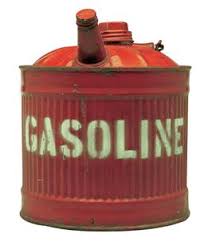Module 3 - Arson and Explosives
Lesson 1- Combustion and Arson
![]()

A pyromaniac is an individual with an intense obsession with fire and periodically has strong desires to start fires intentionally. Starting fires may serve to relieve pyromaniacs of tensions of sadness, loneliness, and rage. Child pyromaniacs frequently suffer from behavioural disorders and/or learning disabilities and often are cruel to animals.
 Combustion
Combustion
A fire is the result of a chemical reaction called combustion and is based on the principles of oxidation. In an oxidation reaction, energy is produced in the form of heat, light, noise, or a combination of these. To start a fire, three things must be present: fuel, oxidant, and heat source.
Fuel in Combustion Reactions
An accelerant is commonly used to start an arson fire. An accelerant is a liquid or solid fuel source that increases the rate of combustion. An accelerant allows the fire to burn at a higher temperature with an increased rate of spread.
Often arsonists use hydrocarbon-based fuels as accelerants, especially ignitable liquids such as gasoline, diesel fuel, kerosene, turpentine, or butane. The combustion of an ignitable liquid actually happens in the gas phase because the liquid  does not actually burn. To ignite, a liquid must be heated to its flash point, the specific temperature at which it changes to a gas and burns.
does not actually burn. To ignite, a liquid must be heated to its flash point, the specific temperature at which it changes to a gas and burns.
Ignitable liquids are dangerous accelerants. Given the right circumstances, they ignite easily and can readily explode. Consequently, arsonists who use large amounts of liquid accelerant to start their fires may suffer serious injuries or death.
Ignitable liquids leave very distinctive burn patterns in the fire debris. To the trained eye, these irregular burn patterns can indicate the presence of an ignitable liquid in a fire.
Some accelerants used in arson fires are solid fuel sources such as common household items that contain wicker, foam, paper, or wood. Using large amounts of solid fuel tends to increase the rate of fire growth and spread the fire over a much larger area, thus increasing the amount of damage.
To determine whether arson was the cause of a fire, investigators look for the presence of accelerants in the debris of the fire. In addition, unusual quantities or types of accelerants can indicate arson, especially when detected in unusual area(s).
Oxidants in Combustion Reactions
In combustion reactions, the oxidant is oxygen gas. The simple word equation for combustion in the presence of oxygen is
fuel + oxygen -> energy + water + carbon dioxide
In most combustion reactions, the necessary oxygen is available in the surrounding air. The air in Earth’s atmosphere contains oxygen as well as a mixture of gases: 78% nitrogen, 21% oxygen, 0.93% argon, 0.04% carbon dioxide, trace amounts of other gases and water vapour.
The Products of Combustion
As a substance burns (undergoes combustion), a complex sequence of exothermic chemical reactions occurs. An exothermic reaction produces heat energy and often light energy as well. When light energy is produced, a flame or glow is visible.
Water and carbon dioxide are also produced during combustion reactions. The water is visible as gas (steam) because of the high temperatures associated with this type of reaction. Carbon dioxide is invisible.
Speed of Ignition
Ignition occurs when the heat produced by the reaction between the fuel and oxygen becomes sufficient to sustain combustion. Three terms are used to describe a fire’s speed of ignition: flash point, ignition range, and flammable range.
- The flash point is the lowest temperature at which enough vapour is produced to permit ignition. The lower the flash point, the greater the risk of fire. The flash point can be reached only if enough fuel, oxygen, and heat are available to support a combustion reaction.
- The ignition range is the temperature at which a combustion reaction can sustain itself without the addition of more fuel or oxygen.
- The flammable range is the relatively high temperature at which ample amounts of fuel produce flames.
The speed of the reaction is determined by how quickly combustion moves through these three ranges. Increasing the temperature can double or even triple the reaction rate.
For a fire to remain ignited, it must have oxygen. If oxygen levels fall below 16%, most fires will extinguish. However, depending on the material(s) being burned, the chemical reaction in a fire can produce substances that contain oxygen; which allows the reaction to continue. For example, burning wood produces carbon dioxide (CO2), carbon monoxide (CO), sulphur monoxide (SO), nitrogen monoxide (NO), and water (H2O). The oxygen released from these gases can continue a fire in the absence of air or oxygen gas (O2).
![]() Flash Point
Flash Point
- The lowest temperature at which the vapour of a combustible liquid can be made to ignite momentarily in air